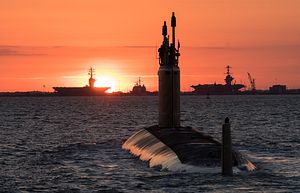BAE Systems has been awarded a contract to build Virginia Payload Modules (VPM) that will more than triple the number of cruise missiles future Virginia-class attack submarines can carry, while providing them the flexibility to accommodate a range of future weapons still under development.
The Virginia-class is the U.S. Navy’s most modern nuclear-powered attack submarine, built to replace the aging Cold War-era Los Angeles-class attack submarines. The first ten Virginias were built with twelve individual vertical launch tubes in their bow section for launching Tomahawk cruise missiles. Blocks III and IV of the class, which will eventually comprise eighteen boats, replace the twelve individual vertical launch tubes with two large-diameter tubes that accommodate round canisters that hold six Tomahawk missiles each, simplifying the reloading process.
The new modules will effectively turn future Virginia-class subs into mini guided-missile subs.
In the early 2000s, the U.S. Navy converted its four oldest Ohio-class ballistic missile submarines, designed to carry nuclear missiles, to carry up to 154 Tomahawk cruise missiles in canisters of seven that fit into the submarine’s large-diameter launch tubes. These original canisters were the inspiration for the large-diameter bow tubes installed on the later Virginias. As the Ohio guided missile submarines reach retirement in coming years the VPM-equipped Virginia-class submarines will replace some of their lost strike capacity.
Nine of the ten planned Block V Virginia-class submarines will be built with the Virginia Payload Module. The module will lengthen the midsection of the Virginia’s hulls to accommodate four large-diameter vertical launch tubes able to carry the same canisters installed on the converted Ohio-class submarines that hold seven Tomahawk cruise missiles. The additional tubes will allow the Virginia’s to carry up to 40 Tomahawk cruise missiles instead of twelve.
The tubes’ large diameter will also allow the Virginias to carry future, larger weapons, like a future hypersonic weapon, a top priority for the Defense Department to compete against China and Russia.
Maneuverable hypersonic weapons travel at greater than five times the speed of sound, making them exceptionally difficult to defend against. Most U.S. hypersonic weapons efforts fall under the Conventional Prompt Global Strike program, whose goal was to enable a conventional strike against a target anywhere on earth in under an hour.
Last October, the U.S. Navy successfully tested a hypersonic conventional prompt strike vehicle at a test range in Hawaii that utilized the same kind of Ohio-class launch tube that will be installed with the Virginia Payload Module.
Concerned about China’s advanced anti-ship missiles and maturing hypersonic weapons, procuring hypersonic strike capabilities was a top priority for Admiral Harry Harris, the former head of U.S. Pacific Command. Admiral Philip Davidson, his relief at the now-renamed Indo-Pacific Command shares Harris’ concern, and testified that a hypersonic capability was essential to compete, deter, and win against China.
Hypersonic weapons are also the Pentagon’s top research and engineering official highest technical priority. In Undersecretary of Defense Michael Griffin’s first public remarks since taking office recently, he said that his goal was to leapfrog the hypersonic advances made by Russia and China, which some other defense officials admitted have already surpassed the United States’ efforts.
“I didn’t take this job so that we could regain parity with our adversaries,” he explained, “I want to make them worry about catching up with us again.” He said that if China deploys a tactical or regional hypersonic weapon system they would be able to hold U.S. carrier strike groups and forward naval forces. In response, the United States needs to be able to defend against hypersonic systems, vulnerability identified in an Air Force Studies Board report in 2016, and have an equivalent offensive capability to hold Chinese forces similarly at risk.
Without its own hypersonic capabilities of its own, the United States would be forced to either let China have its way, or respond with nuclear weapons, Griffin concluded, “and that should be an unacceptable situation for the United States.”

































